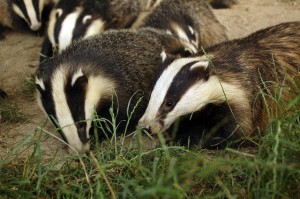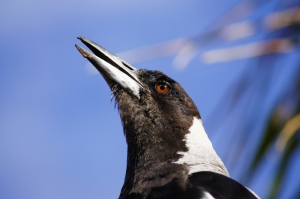Originally published July 2015
Hello everyone! Litha has come and gone, or still here if you follow Bede’s calendar (see July 2013). Puc’s night, brief and depressingly damp as it was, signalled the time when the old Sun God was at the peak of his strength and light and life at their most abundant. Personally I always feel a slight twinge of sadness at this time of year, as the magnificent displays of Bluebell, Ramson, Hawthorn and many of the other wild flowers are but distant memories and even the trees start to take on a slightly world-weary appearance.  Fox and Badger cubs seen gambolling joyfully, under the watchful eye of their parents, just a few months ago are now strapping juveniles and well used to venturing forth by themselves. They still enjoy a bit of rough and tumble in the form of play fighting but will soon be concentrating on the serious business of habitual eating and adding essential fat reserves to their rapidly expanding frames.
Fox and Badger cubs seen gambolling joyfully, under the watchful eye of their parents, just a few months ago are now strapping juveniles and well used to venturing forth by themselves. They still enjoy a bit of rough and tumble in the form of play fighting but will soon be concentrating on the serious business of habitual eating and adding essential fat reserves to their rapidly expanding frames.
The Dawn Chorus may have faded in its intensity but the long hours of daylight are still dominated by the sounds of the feathered folk, despite the fact that the breeding season is all but finished. This leads me nicely into the main topic of this month’s ramblings. How many of us lie in bed on an early summer’s morning, gradually coming to, as a Blackbird serenades us from the top of a tree. He might be joined by Finches, Warblers, Tits and a variety of songbirds lending their voices to a harmonious wave of sound that eases us into consciousness. Suddenly the air is rent with a great crack as monstrous wings flap into close proximity.
 You cast your semi-traumatised mind back to all the creatures of legend Ray Harryhausen brought to life and prepare for one of Zeus’ most fearsome Harpies to come crashing (in glorious stop frame animation) into the bedroom. A second of silence, another second, and then someone attempts to jump-start a vacuum cleaner directly outside your window!
You cast your semi-traumatised mind back to all the creatures of legend Ray Harryhausen brought to life and prepare for one of Zeus’ most fearsome Harpies to come crashing (in glorious stop frame animation) into the bedroom. A second of silence, another second, and then someone attempts to jump-start a vacuum cleaner directly outside your window!
Of course it is at this point that you wake up fully and wonder if Ma Nature had been feeling particularly distracted on the day she gave one of our most common birds, the Wood Pigeon (Columba palumbas), its familiar, repetitive call.  In fairness to the Pigeon, many other birds produce sounds that can be just as harsh on the ear at times. For instance the bickering screech of a Magpie (Pica pica), reminiscent of a vocally dexterous child imitating a machine gun, does nothing for a smooth transition out of the Land of Nod.
In fairness to the Pigeon, many other birds produce sounds that can be just as harsh on the ear at times. For instance the bickering screech of a Magpie (Pica pica), reminiscent of a vocally dexterous child imitating a machine gun, does nothing for a smooth transition out of the Land of Nod.
However, it is the Wood Pigeon we are interested in this month as their call is dominating the countryside at present. As I write this I can hear the familiar sound floating through the window, and it has to be said that on a mellow summer’s afternoon, when it is not on your windowsill, it is very relaxing and, unlike the previous encounter, has a soporific quality. The bird is Europe’s largest pigeon and is striking with its pink breast and green, white and purple patch on its neck. The Pigeon is similar in appearance to the, less-common, Stock Dove (Columba oenas), the main differences being the white patch on the neck and distinctive white, wing bars. The dove has a shorter tail and two black bars on each wing.

Both species have a charming little courtship ritual that would not have looked out of place in a Jane Austin novel. The female adopts a demure posture with her head and back held horizontally whilst the male performs a graceful bowing display.  During this declaration of his undying affection he uses his wings, in a most Darcy-like manner, to point out the best nesting sites in the area.
During this declaration of his undying affection he uses his wings, in a most Darcy-like manner, to point out the best nesting sites in the area.
One key difference between the species is the slight difference in the shape of the bill. The slender beak of the Stock Dove is ideal for picking seeds up off the ground. This is their main food source and accounts for their relatively low numbers. Once the autumn is over, there is not enough food to support a large over-wintering population. In contrast the Wood Pigeon, which is estimated to be about thirty times more common than the dove, has a stout bill which is less specialised but allows the bird to have a more varied diet. It is this feature which puts it top of the list of agricultural pests. It eats anything from nuts, acorns and tree flowers to grain and the leaves of brassicas and will decimate fields of clove, kale, cabbages and Brussels sprouts. It is for this reason that, under the law, the bird can be shot at any time of the year.
All pigeon and doves belong to the Order of Columbiformes, a group consisting of three Families: the Columbidae, Pigeons and Doves; the Pteroclididae, Sandgrouse; and the extinct Raphidae, the Dodo (Raphus cucullatus) and the Solitaire (Raphus solitarius). The latter Family consisted of flightless birds both exterminated by colonists and the animals they introduced. If you think that taxonomists may have got it wrong with such an unlikely relationship then take a look at a Pigeon chick. Known as Squabs, they bear a remarkable resemblance to a sketch of a Dodo which was discovered two years ago in the Ashmolean Museum, Oxford.

The infamous hunting of the Passenger Pigeon (Ectopistes migratorius) to extinction gave us the unique and poignant knowledge of the exact moment when a species became extinct. On September 1st 1914 Martha, the last individual of her species, died in Cincinnati zoo. The species had been reduced from over 3 billion to zero in less than fifty years. This point is worth remembering when assessing the conservation status of even the most common animal which is considered to be of pestilential significance.
The name Pigeon is believed to have derived from the Latin pipio, to chirp or a pipe, whereas the word Dove is of Norse origin. It is interesting that Saint Columba did not receive his Dove of the Church monika until he trained as a priest. His original name, so legend tells us, was Crimmthann or Fox!
Tis a bird I love, with its brooding note, And the trembling throb in its mottled throat; There’s a human look in its swelling breast, And the gentle curve of its lowly crest;
Nathaniel Parker Willis (1806-67)
So there it is, a very brief foray into the life of one of our most common birds, menace to farmers, handsome denizen of the woods and, not always welcome, alarm clock!
 At this point I must thank everyone who let me know of their Cuckoo ‘sightings’, or at least heard the familiar call this year. Sadly, despite my rambling around the woods and lanes, and for the second year running, I did not hear our visitor from Africa. Thank you Pam and Jill who both heard one around Crowhurst on different days in April. On the Facebook page I had posts from Aquitaine, France right up to North Wales, strangely before the local bird or birds were heard. I hope we can continue the survey next year and that we may see an increase in numbers in this area.
At this point I must thank everyone who let me know of their Cuckoo ‘sightings’, or at least heard the familiar call this year. Sadly, despite my rambling around the woods and lanes, and for the second year running, I did not hear our visitor from Africa. Thank you Pam and Jill who both heard one around Crowhurst on different days in April. On the Facebook page I had posts from Aquitaine, France right up to North Wales, strangely before the local bird or birds were heard. I hope we can continue the survey next year and that we may see an increase in numbers in this area.
Enjoy your summer and please take the opportunity to make the most of our natural treasures, there is no guarantee they will be around for ever!
Put me right at pgcrow@yahoo.com
Paul Johnson
And don’t forget the moth spotting event on Sunday 19th July…
Image 1: Badgers by Tim Brookes used under Creative Commons License 2.0; Image 3: Singing Magpie by Paul used under CC2.0; Image 4: Wood pigeon by Dave McLear used under CC2.0; Image 5: Stock dove by Dave Curtis used under CC2.0; Image 7: Wood pigeon nestlings by Nottsexminer used under CC2.0; Image 8: Dodo_head by William Clift (1775-1849) – public domain; Image 9: Cuckoo by Sue used under CC2.0
